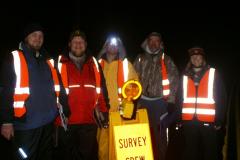Amphibians Crossing!
Since 2002 we have worked to protect early-spring breeding amphibians like the wood frog, spotted salamander, jefferson salamander, and spring peeper during their annual migrations, which often lead them across perilous roadways.
The Migration
We all know that “April showers bring May flowers,” but the earlier rains of March stir up beauties of a different kind. When the first Spring raindrops hit the barely-thawed ground and night falls on the forest, a menagerie of frogs, salamanders, and toads emerge from their winter burrows to jump-start the season. These amphibians – the spotted salamanders, wood frogs, spring peepers, and others – are anxious to get to their breeding pools and lay their eggs.
The waters that they choose are called vernal pools because they fill with rainwater, snowmelt, and rising groundwater in early spring but then dry up as summer advances. The pools are thus temporary and cannot support fish, meaning fewer predators for the amphibian eggs and young. But to survive the dry-out themselves, the new generation of amphibians must race to complete metamorphosis and leave the pool before the water does.
So that’s what all the haste is about. Under perfect conditions of warm (>40ºF), thawing, nighttime rains, there may be hundreds or even thousands of amphibians moving at once toward the same breeding pool. The darkness and the rain allow them to move stealthily over the landscape, hidden from predators like the owl and raccoon. Most people will never notice their migration either.
 Zoom+ A late-night amphibian rescue squad keeps frogs and salamanders moving on their merry way. Pictured left-to-right are Dave Clapp, Evan Madlinger, Mike VanClef, Jim Angley, and MacKenzie Hall. © Mike Anderson
Zoom+ A late-night amphibian rescue squad keeps frogs and salamanders moving on their merry way. Pictured left-to-right are Dave Clapp, Evan Madlinger, Mike VanClef, Jim Angley, and MacKenzie Hall. © Mike Anderson
The Problem
The problem in a place like New Jersey is that we’ve criss-crossed a web of roads and developments across the land. Habitat loss aside, many of our frogs, salamanders, and toads must now challenge traffic in order to get where they need to go.
A single vehicle can crush dozens of these slow-moving animals as they try to cross the road during migration. From the driver’s seat they may look like mere twigs, leaves, or raindrops bouncing off the road. With high mortality rates year after year, it doesn’t take long for a population to nose-dive.
The Solutions
The Conserve Wildlife Foundation has been partnering with NJ’s Endangered and Nongame Species Program (ENSP) since 2002 to protect early-spring breeding amphibians like the wood frog, spotted salamander, Jefferson salamander, and spring peeper during their annual migration. On peak nights each Spring, we work with a fleet of incredible volunteers to hustle amphibians across the road at rescue sites, collect data on the numbers and species seen, measure the impacts of vehicular traffic, and document additional amphibian crossings for future protection. A lovely article in the New York Times (April 2009) described our group as “chaperones to an amphibian dance.”
 Zoom+ A wood frog is helped across the road. © MacKenzie Hall
Zoom+ A wood frog is helped across the road. © MacKenzie Hall
We continue these efforts from year to year as we work toward a more sustainable long-term vision. We hope that townships and community groups will use our model to take on protection of their local amphibians and to make road closures and/or volunteer efforts a part of the annual repertoire.
Additionally, an under-road tunnel system is planned for installation at our busiest amphibian crossing site during the winter of 2023-24. Successful “critter crossings” at this priority site could pave the way for many other road permeability projects, allowing salamanders, frogs, and toads (as well as snakes, turtles, and other small animals) to safely and independently cross between their upland habitats and breeding pools each spring.
Would you like to help?
- You can help us find and safeguard amphibian road-crossings by letting us know where you’ve seen them or by volunteering with our Amphibian Crossing Project.
- We are not seeking anymore volunteers for 2024 but if you are interested in signing up to receive updates about future volunteer opportunities, then please fill out this form.
- This project is currently limited to northern New Jersey.
Learn More
- To learn more about similar habitat connectivity initiatives statewide, visit New Jersey Division of Fish and Wildlife's CHANJ webpage.
- Connecting Habitat: Waterloo Road - Story Map
- Watch the full Nature in a New York Minute video about our Amphibian Crossing Project...it's the next-best thing to being there!
- This season, learn more about the incredible lives of amphibians found right here in NJ! For field guides and CDs, visit our Store.
For more information, contact:
Christine Healy, Wildlife Biologist: Email
Find Related Info: Amphibians






